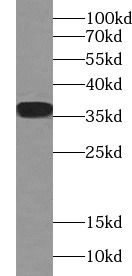Products
IL33 antibody
| Synonyms: | Interleukin-33 (IL-33)|Interleukin-1 family member 11 (IL-1F11)|Nuclear factor from high endothelial venules (NF-HEV)|Interleukin-33 (95-270)|Interleukin-33 (99-270)|Interleukin-33 (109-270)|IL33|C9orf26|IL1F11|NFHEV antibody | ||
| Catalogue No.: | FNab04272 | Reactivity: | Human |
| Host: | Mouse | Tested Application: | ELISA, IHC, WB |
| Clonality: | monoclonal | Isotype: | IgG1 |
| Size | Price |
|---|---|
| 100µg | Inquiry |
- SPECIFICATIONS
- FIGURES
- CONDITIONS
- FAQS
- Product Name
- IL33 antibody
- Catalogue No.
- FNab04272
- Size
- 100μg
- Form
- liquid
- Purification
- Protein A+G purification
- Purity
- ≥95% as determined by SDS-PAGE
- Clonality
- monoclonal
- Isotype
- IgG1
- Clone ID
- 4E8
- Storage
- PBS with 0.02% sodium azide and 50% glycerol pH 7.3, -20℃ for 12 months(Avoid repeated freeze / thaw cycles.)
- Immunogen
- interleukin 33
- Alternative Names
- Interleukin-33 (IL-33)|Interleukin-1 family member 11 (IL-1F11)|Nuclear factor from high endothelial venules (NF-HEV)|Interleukin-33 (95-270)|Interleukin-33 (99-270)|Interleukin-33 (109-270)|IL33|C9orf26|IL1F11|NFHEV antibody
- UniProt ID
- O95760
- Observed MW
- 35 kDa
- Tested Applications
- ELISA, IHC, WB
- Recommended dilution
- WB: 1:500-1:2000; IHC: 1:50-1:500
 HepG2 cells were subjected to SDS PAGE followed by western blot with FNab04272(IL33 Antibody) at dilution of 1:1000
HepG2 cells were subjected to SDS PAGE followed by western blot with FNab04272(IL33 Antibody) at dilution of 1:1000
 Immunohistochemistry of paraffin-embedded human nasopharyngeal carcinoma tissue slide using FNab04272(IL33 Antibody) at dilution of 1:200
Immunohistochemistry of paraffin-embedded human nasopharyngeal carcinoma tissue slide using FNab04272(IL33 Antibody) at dilution of 1:200
- Background
- Cytokine that binds to and signals through the IL1RL1/ST2 receptor which in turn activates NF-kappa-B and MAPK signaling pathways in target cells(PubMed:16286016). Involved in the maturation of Th2 cells inducing the secretion of T-helper type 2-associated cytokines. Also involved in activation of mast cells, basophils, eosinophils and natural killer cells. Acts as a chemoattractant for Th2 cells, and may function as an "alarmin", that amplifies immune responses during tissue injury(PubMed:17853410, PubMed:18836528). In quiescent endothelia the uncleaved form is constitutively and abundantly expressed, and acts as a chromatin-associated nuclear factor with transcriptional repressor properties, it may sequester nuclear NF-kappaB/RELA, lowering expression of its targets(PubMed:21734074). This form is rapidely lost upon angiogenic or proinflammatory activation(PubMed:18787100).
How many times can antibodies be recycled?
First, usually it's not suggested to recycle antibodies. After use, buffer system of antibodies has changed. The storage condition of recycled antibodies for different customers also varies. Thus, the performance efficiency of recycled antibodies can’t be guaranteed. Besides, FineTest ever conducted the antibody recycling assay. Assay results show recycling times of different antibodies also varies. Usually, higher antibody titer allows more repeated use. Customers can determine based on experimental requirements.
Notes: After incubation, we recycle rest antibodies to centrifuge tube and store at 4℃. High titer antibodies can be stored for a minimum of one week. Reuse about three times.
What are components of FineTest antibody buffer?
Components of FineTest antibody buffer are usually PBS with proclin300 or sodium azide, BSA, 50% glycerol. Common preservative is proclin300 or sodium azide, which is widely applied in the lab and industry.
How about the storage temperature and duration of FineTest antibodies?
Most antibodies are stored at -20℃. Directly-labeled flow cytometry antibodies should be stored at 2 - 8℃. The shelf life is one year. If after sales issues for purchased antibodies appear, return or replacement is available. Usually, antibodies can be still used after the one-year warranty. We can offer technical support services.
Is dilution required for FineTest antibodies? What’s the dilute solution?
Directly-labeled flow cytometry antibodies are ready-to-use without dilution. Other antibodies are usually concentrated. Follow the dilution ratio suggested in the manual. Dilute solution for different experiments also varies. Common antibody dilution buffers are acceptable(e.g. PBST, TBST, antibody blocking buffer).
How to retrieve antibodies for immunohistochemistry?
Common retrieval buffers: Tris-EDTA Buffer(pH 9.0); Citrate Buffer(pH 6.0)
Heat induced antibody retrieval:
Method 1: Water-bath heating: Put the beaker with retrieval buffer and slide in the boiling water bath. Keep the boiling state for 15min. Naturally cool to room temperature;
Method 2: Microwave retrieval: Put the beaker with retrieval buffer and slide in the microwave oven. Heat at high power for 5min, Switch OFF for 3min, Heat at medium power for 5min. Naturally cool to room temperature.
How to choose secondary antibodies?
(1) Secondary antibodies react with primary antibodies. Thus, secondary antibodies should be against host species of primary antibodies. E.g. If the primary antibody is derived from rabbit, the relevant secondary antibody should be against rabbit. E.g. goat anti rabbit or donkey anti rabbit.
(2) Choose secondary antibody conjugates according to the experimental type, e.g. ELISA, WB, IHC etc. Common enzyme conjugated secondary antibodies are labelled by HRP, AP etc. Fluorescin or dye labelled secondary antibodies are applied in immunofluorescence and flow cytometry(e.g. FITC, Cy3).
